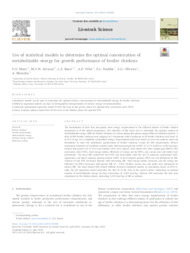Use of statistical models to determine the optimal concentration of metabolizable energy for growth performance of broiler chickens.
Use of statistical models to determine the optimal concentration of metabolizable energy for growth performance of broiler chickens.
Author(s): MARX, F. O.; ALVAREZ, M. V. N.; BASSI, L. S.; FÉLIX, A. P.; KRABBE, E. L.; OLIVEIRA, S. G.; MAIORKA, A.
Summary: Abstract: The formulation of diets that adequately meet energy requirements in the different phases of broiler chicken production is of the utmost importance. The objective of this study was to determine the optimal content of metabolizable energy (ME) for broiler chickens in various production phases using different statistical models. A total of 900 broiler chickens were assigned to 5 treatments with 9 replicates of 20 broiler chickens each from 21 to 42 d of age in a completely randomized design. Experimental diets were based on corn and soybean meal and formulated to meet the nutritional requirements of broiler chickens, except for ME requirements. Dietary treatments consisted of 5 pelleted/crushed diets with increasing levels of ME: T1 to T5 (2,850 to 3,250 kcal/kg), divided into grower (21 to 35 d) and finisher (35 to 42 d) phases. Feed intake (FI), body weight gain (BWG), feed conversion ratio (FCR), total energy intake, efficiency of energy use for BWG, and carcass and cuts yields were determined. The ideal ME content for best FCR was determined with the use of quadratic polynomial (QP), segmented, and linear response plateau models (LRP). In all evaluated periods, BWG was not influenced by ME, whereas FI and FCR decreased linearly with increasing ME. Total energy intake increased and the energy use efficiency for BWG decreased with greater ME (P < 0.05). Neither carcass nor cuts yields were influenced by dietary ME. The ideal dietary ME content differed between statistical models. In conclusion, based on FCR results, the QP regression model presented the best fit of the data in the grower phase, indicating an optimal content of metabolizable energy for feed conversion of 3,264 kcal/kg, whereas LRP presented the best data adjustment in the finisher phase, indicating 3,224 kcal/kg of ME as optimal.
Publication year: 2023
Types of publication: Journal article
Unit: Embrapa Swine & Poultry
Observation
Some of Embrapa's publications are published as ePub files. To read them, use or download one of the following free software options to your computer or mobile device. Android: Google Play Books; IOS: iBooks; Windows and Linux: Calibre.
Access other publications
Access the Agricultural Research Database (BDPA) to consult Embrapa's full library collection and records.
Visit Embrapa Bookstore to purchase books and other publications sold by Embrapa.

